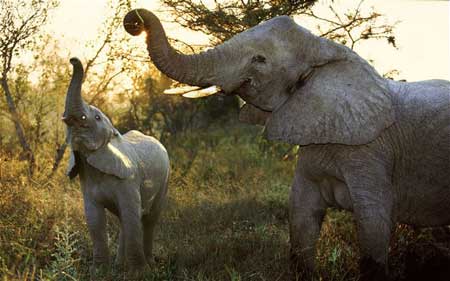
|
If you have ever wondered how an elephant smells, scientists have the answer. Pretty good. Researchers have discovered that African Elephants have the largest number of genes dedicated to smell of any mammal. Given the size of their trunks, and how important it is to their survival, it is probably unsurprising that an elephant’s nose is not only the longest in the animal kingdom, but also the most effective. In comparison, humans and other primates have a poor sense of smell. "The functions of these genes are not well known, but they are likely important for the living environment of African elephants," said author Dr Yoshihito Niimura of the University of Tokyo. "Apparently, an elephant's nose is not only long but also superior. The sense of smell is critical to all mammals, and they use it for sniffing out food, avoiding predators, finding mates and locating their offspring. In a study published in Genome Research, scientists examined the 13 mammal species and found that African Elephants have twice the number of smell genes as dogs and five times more than humans. They have around 2,000 genes alone that are dedicated to scent. Humans in comparison have just under 400 and other primates like chimpanzees, even less. The study found that 20,000 genes are responsible for the sense of smell in mammals, of which around half are functional, but the collections differ for each species. Horses have around 1,000 smell genes, rabbits around 750 and rats about 1,200. “The large repertoire of elephant (smell) genes might be attributed to elephants’ heavy reliance on scent in various contexts, including foraging, social communication, and reproduction,” added Dr Niimura African and Asian elephants possess a specific scent gland, called the temporal gland, behind each eye, and male elephants exude an oily secretion during annual mating, which is characterized by increased aggressiveness and elevated levels of testosterone . Research has also shown that elephants have well-developed olfactory systems that include large olfactory bulbs and large olfactory areas in the brain. And previous studies have revealed that, African elephants can reportedly distinguish between two Kenyan ethnic groups—the Maasai, whose young men demonstrate virility by spearing elephants, and the Kamba, who are agricultural people that pose little threat to elephants through smell. The sense of smell evolved over millions of years and our human ancestors would have used it as a tool to spot disease, avoid rotten meat and poisonous plants and sniff out food. However our upright posture lifted our noses far from the ground where most smells originate, diluting scent molecules in the air. And today many smells which still give us hints about rot and poor hygiene are masked behind perfumes, air fresheners and deodorants. Yet smells are still having a greater impact than we realise, warning of danger, triggering memories and even helping us choose a partner. Many studies have shown that pheromones emitted from the sweat glands play an important role in physical attraction. Some experts believe that humans have a far greater sense of smell than previously thought but daily showers and fridges, which mask bad odours, have stopped us noticing. Previously it was estimated that we could smell 10,000 odours but now researchers say it is more like one trillion. Scientists believe our sense of smell is much closer to that of animals than appreciated, but we no longer pay attention because smells are often hidden, meaning that important information is lost. Mammal Number of genes Elephant 1948 Cow 1186 Dog 811 Horse 1066 Rabbit 768 Guinea Pig 796 Rat 1207 Mouse 1130 Marmoset 366 Macaque 309 Orangutan 296 Chimapanzee 380 Human 396 |
如果你想知道大象是怎么闻气味的,科学家们找到答案了。 据《每日电讯报》网站报道,研究人员发现,非洲大象拥有数量最多的基因,这些基因有利于所有哺乳动物的嗅觉。 鉴于其鼻子的大小以及其对他们生存的重要性,大象的鼻子不仅是动物王国里最长的,它无疑也是嗅觉最灵敏的。 相比之下,人类和其他灵长类动物的嗅觉较不灵敏。 该研究作者东京大学的吉人新村(Yoshihito Niimura)博士说,“这些基因的功能并不为人所熟知,但它们对非洲象的生存环境可能很重要。” “显然,大象的鼻子不仅长,而且还更高级。” 嗅觉对所有的哺乳动物都很关键。他们用鼻子来嗅出食物,躲避捕食者,寻找配偶甚至找寻他们的后代。 发表在基因组研究的研究中,科学家们研究了13种哺乳动物,发现非洲大象的嗅觉基因数是犬类的两倍,是人类的5倍。 他们大约有2000个基因,用于嗅出气味。相比较而言,人类的嗅觉基因不到400个,其他灵长类动物比如猩猩,甚至还更少。 研究发现,在哺乳动物中,2万个基因负责闻气味,其中约一半的基因是功能性的,但这种集合在不相同的物种中各不相同。 马大约有1000个嗅觉基因,兔子约有750个嗅觉基因家兔,而大老鼠约有1200个 。 新村博士补充说:“属大型剧目的大象的(气味)基因,可能是由于在各种情况下,大象对气味的严重依赖。包括觅食,社交及再生育。” 非洲和亚洲大象拥有一个特殊的臭腺,称为颞腺。颞腺在两只眼睛的后面,公象在每年的交配期散发出一种油性分泌物,其特点是攻击性增强,睾酮水平升高。 研究还表明,大象有发达的嗅觉系统,包括在大脑中的大型嗅球茎和嗅大区。 之前的研究显示,据说,非洲象可以分辨两个肯尼亚民族——马赛族(Maasai)和康巴族(Kamba)。马赛族的年轻人以刺戳大象展现男性气概;康巴族人多从事农耕,较少对大象造成威胁。非洲象能通过气味分辨出来。 嗅觉进化了数百万年。而我们人类的祖先用它作为发现疾病的工具,避免食用腐烂的肉和有毒植物并嗅出可食物。 然而,大多数气味源自地面。我们人类进化的直立站姿让我们的鼻子离地面较远,气味分子在空气中被稀释了。 如今,我们能闻出因为卫生条件差或者腐烂散发的味道。我们用香水、空气清新剂和除臭剂掩盖臭味。 然而,嗅觉仍比我们想像的影响还要大。它能意识到危险,引起回忆,甚至帮助我们选择同伴。 许多研究表明,从汗腺发出的信息素对物理吸引力起着重要作用。 有专家认为,人类的嗅觉比以前更灵敏了。但每天的淋浴和制冷掩盖了不好的气味,已经让我们不再意识到一些臭味了。 此前,据估计,我们可以闻到10万种气味。但现在研究人员说,我们更可能闻到上万亿种气味。 科学家们相信,人类的嗅觉比想象中更接近动物的嗅觉。但我们不再专注于味觉研究对比,。因为气味经常是隐藏的,也就是说,重要的信息都丢失了。 哺乳动物的基因数量 大象 1948 牛 1186 狗 811 马 1066 兔子 768 天竺鼠 796 大老鼠 1207 老鼠 1130 狨猴 366 猕猴 309 猩猩 296 黑猩猩 380 人类 396 扫一扫,关注微博微信
  (译者 1193614809 编辑 齐磊) |
